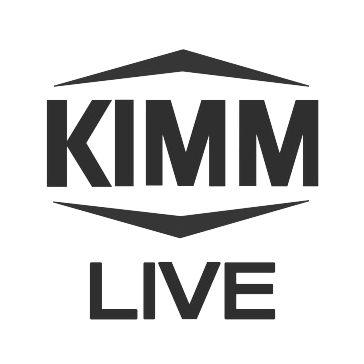
- Created2022.03.14
The Development of the World’s First Distortion-Free Stretchable Micro-LED Meta-Display Technology
- Development of a stretchable display where images can be transversely/ longitudinally stretched up to 25% without distortion -
- Results of this study have been published in Advanced Functional Materials -
The Korea Institute of Machinery and Materials (President Sang Jin Park, hereafter referred to as KIMM), an institute under the jurisdiction of the Ministry of Science and ICT, has successfully developed a new stretchable meta-display technology that can be stretched up to 25% without image distortion, for the first time in the world.
Senior researcher Dr. Bongkyun Jang and his research group members of the Department of Nano-Mechanics at KIMM have recently developed a distortion-free stretchable meta-display under the uniaxial stretching, and published their research results in the peer-reviewed journal Advanced Functional Materials.
* Paper Title: Auxetic Meta-display: Stretchable Display without Image Distortion (published online on Feb. 15, 2022)
This achievement was developed through the “Development of Meta-display Technology Based on Micro-LEDs ” project carried out in 2019 as part of the Ministry of Science and ICT’s Global Frontier Project, with support from the Center for Advanced Meta-Materials (Director Dr. HakJoo Lee, hereinafter referred to as CAMM). The Department of Nano-Mechanics at KIMM has been researching the field of micro-LED transfer technology since 2008.
For the first time in the world, the KIMM research team successfully developed a 3-inch microLED meta-display that does not distort the displayed image, even when the display is pulled in a given direction. This was achieved by using the design and manufacturing technology of metamaterials with unique mechanical properties that do not exist in nature.
Most stretchable materials in nature, such as rubber, demonstrate the shrinkage in width when stretched lengthwise and thus resulting in image distortion. This was also the same in cases of the rubber-based stretchable display, up until now.
The KIMM research team applied mechanical metamaterials with a negative Poisson’s ratio to a circuit board. The Poisson’s ratio refers to the ratio at which the width of material shrinks when it is stretched lengthwise. When a mechanical metamaterial with a Poisson’s ratio of -1 is stretched lengthwise, it demonstrates the effect of stretching at the same ratio widthwise. Thus, a display using such materials is characterized by images that are not distorted.
In developing this new meta-display manufacturing technology, the team applied mechanical metamaterial designs and manufacturing technology to the world’s leading large-area micro-LED roll transfer technology. Based on the successful results of this project, the research team plans to conduct follow-up research on micro-LED displays for ultra-realistic metaverses.
Furthermore, in order to respond to the growing mini-LED and graphene industries, the team has established research institute spin-off company, YTS Micro-Tech and MCK-Tech, to promote the practical use of these new technologies.
Dr. Bongkyun Jang stated that his team has solved the fundamental issue of image distortion in stretchable displays by using meta-structures, and he and his team will continue to pursue the commercialization of meta-display technologies, so that they can be applied to various electronic products in the future.
The newly developed flexible meta-display technology is expected to contribute to the diversification of platforms for mobile electronic devices, such as mobile phones and tablets. Such displays can also adhere to the skin of the human body without any wrinkles, thus allowing possibilities for its application in the field of medical devices, beauty and healthcare.
[List of Attachments] - Attachment 1: About the Center for Advanced Meta-Materials (CAMM)
- Attachment 2: Conceptual diagram of stretchable display without image distortion (Figure)
- Attachment 3: Comparison image before and after stretching the meta-display (Image)
- Attachment 4: Meta-display manufacturing process diagram using micro-LED large-area transfer technology (Figure)
- Attachment 5: Comparison between conventional stretchable display and meta-display (Image)
- Attachment 6: Curved display image using meta-display (Image)
The Korea Institute of Machinery and Materials (KIMM) is a non-profit governmentfunded research institute under the Ministry of Science and ICT. Since its foundation in 1976, KIMM is contributing to economic growth of the nation by performing R&D on key technologies in machinery and materials, conducting reliability test evaluation, and commercializing the developed products and technologies.
This achievement was developed through the “Development of Meta-display Technology Based on Micro-LEDs ” project carried out in 2019 as part of the Ministry of Science and ICT’s Global Frontier Project, with support from the Center for Advanced Meta-Materials (Director Dr. Hak-Joo Lee). KIMM senior researcher Dr. Bongkyun Jang and his research group members have published their research results in the peer-reviewed journal Advanced Functional Materials, with the title “Auxetic Meta-display: Stretchable Display without Image Distortion”. (DOI: https://doi.org/10.1002/adfm.202113299)
Credit : The Korea Institute of Machinery and Materials (KIMM)
Usage Restrictions of Multimedia (Attachment File) : The sources of photos and research results from KIMM must be specified.
- Attachment 1: About the Center for Advanced Meta-Materials (CAMM)
The Center for Advanced Meta-Materials (CAMM) was established in 2014 to develop source technologies for electromagnetic and mechanical metamaterials and put them into practice. Over the past seven years, through participation in convergence research with various universities and research institutes under the guidance of KIMM, CAMM has applied for more than 480 patents in the fields of displays, ultrasonic sensors, sound absorption and sound insulation, bio-diagnostics and treatment, and military stealth technology and has published around 760 SCI-grade papers.
Through development projects on micro-LED technology supported by CAMM, several efforts have been made to apply such developed technologies in practical settings. For example, 19 SCI-grade papers have been published in the fields of manufacturing processes for meta-displays, large-area manufacturing equipment, meta-stamps, meta-circuit boards, micro-LED repair, and meta-display applications. There also have been 54 patent applications (32 domestic and 22 overseas), along with five technology transfer projects (295 million KRW) and the establishment of two research institute spin-off companies..
Furthermore, CAMM has added about 20 micro LED-related patents owned by the KIMM to its list of patents and formed the Industrial Affiliates Program (IAP) in the field of meta-displays in an effort to recruit participating companies. It also plans to select and support corporate consortium tasks with the goal of creating a meta-display industry ecosystem.
Website: https://www.camm.re.kr/eng
- Attachment 2: Conceptual diagram of stretchable display without image distortion (Figure)
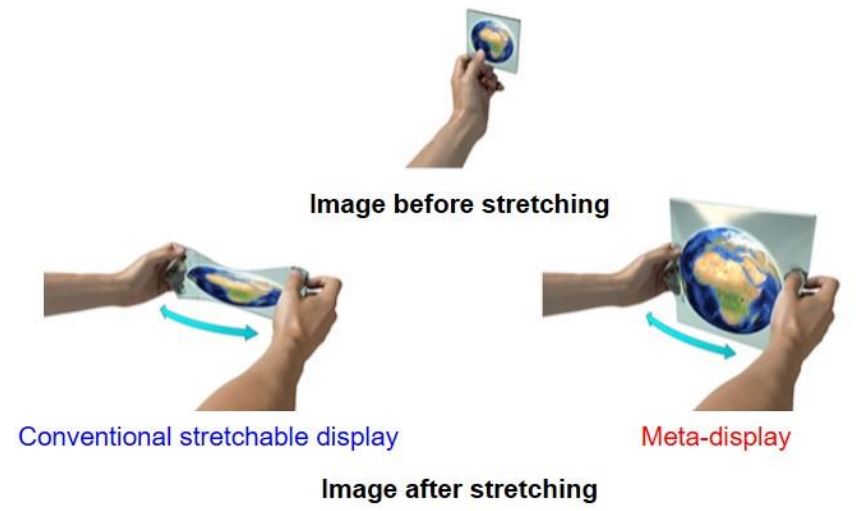
Description: When stretched lengthwise, the conventional stretchable display shrinks widthwise, resulting in the distortion of the displayed image. However, since the meta-display stretches at the same ratio widthwise when stretched lengthwise, it is possible to stretch the display without any image distortion.
- Attachment 3: Comparison image before and after stretching the meta-display (Image)
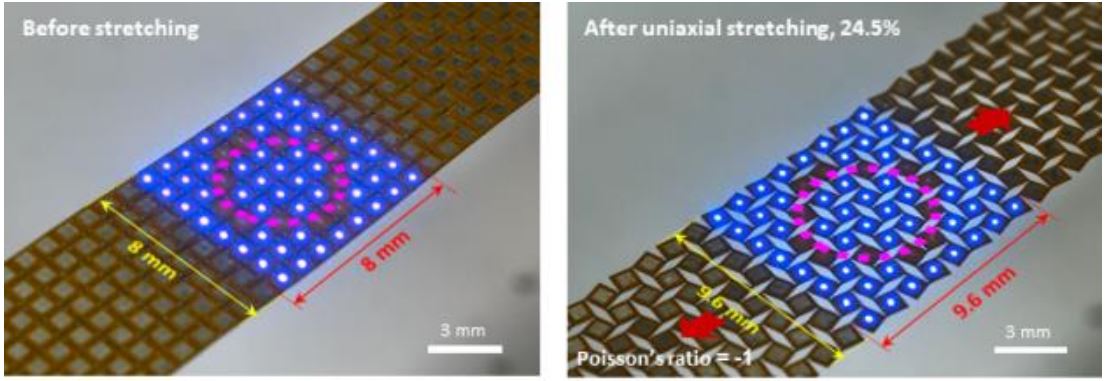
Description: When the meta-display is stretched lengthwise, it is also stretched widthwise at the same ratio, so that the displayed image can be expanded without distortion.
- Attachment 4: Meta-display manufacturing process diagram using micro-LED largearea transfer technology (Figure)
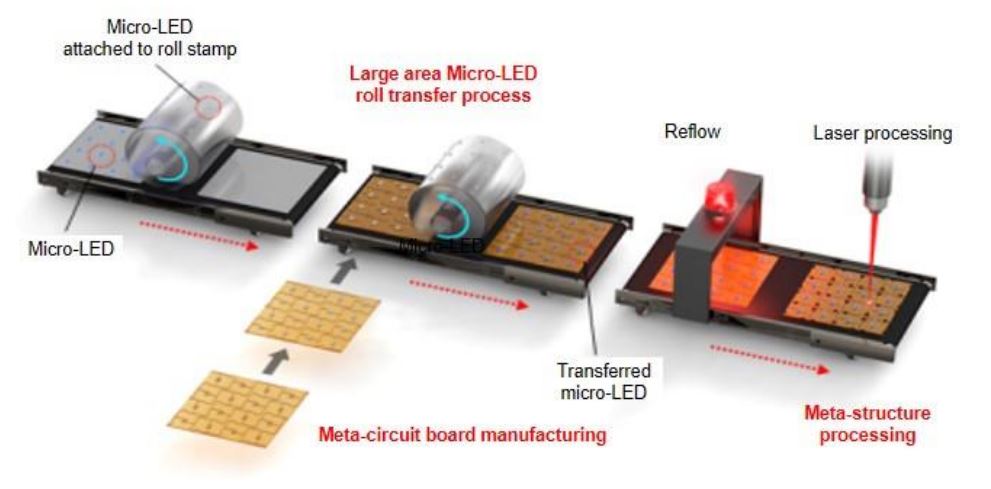
Description: A meta-display can be manufactured by transferring a micro-LED device to a large-area meta-circuit board using roll-based large-area transfer technology. After micro-LED transfer, the meta-display is manufactured through reflow and meta-structure processing using a laser.
- Attachment 5: Comparison between conventional stretchable display and meta-display (Image)
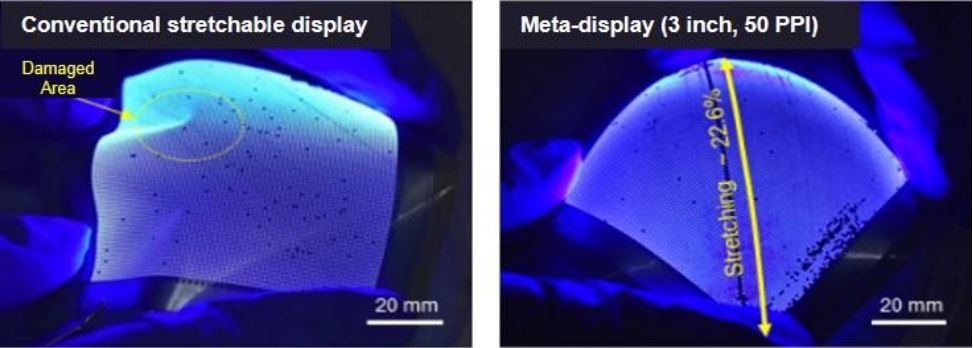
Description: A 3-inch meta-display and a conventional stretchable display are attached to a hemispherical surface with a radius of 80 cm. The conventional stretchable display shows wrinkles and creases occur, but the meta-display is attached smoothly without any damage.
- Attachment 6: Curved display image using meta-display (Image)
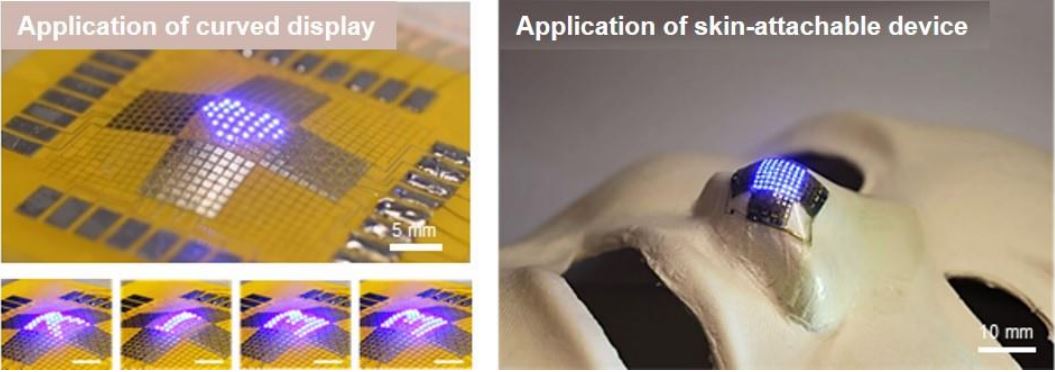
Description: The manufacturing of curved displays that use meta-displays to display images and devices that can be attached to the skin.

